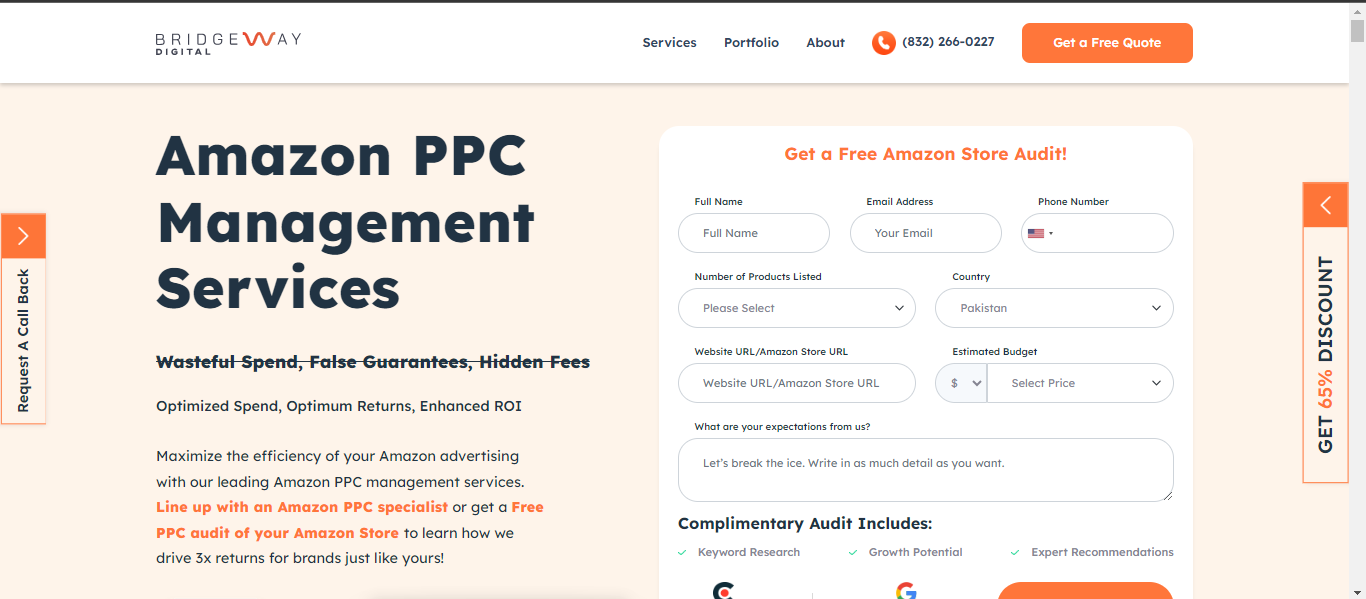Amazon PPC (Pay-Per-Click) advertising is an essential tool for sellers who want to maximize their visibility, drive targeted traffic, and increase sales on the Amazon marketplace. This guide will provide you with everything you need to know about Amazon PPC services, from understanding the basics to implementing advanced strategies.
1. What is Amazon PPC?
Amazon PPC is a paid advertising model where sellers bid on keywords to have their products displayed in prominent positions on Amazon’s search results and product detail pages. Sellers are charged each time a customer clicks on their ad.
- How Amazon PPC Works:
- Bidding on Keywords: Sellers bid on keywords that are relevant to their products. When a customer searches for those keywords, Amazon’s algorithm determines which ads to display based on the bid amount and relevance.
- Pay-Per-Click Model: You only pay when someone clicks on your ad, making it a cost-effective way to drive targeted traffic to your product listings.
- Benefits of Amazon PPC:
- Increased Visibility: Ads appear at the top of search results, giving your products higher visibility.
- Targeted Traffic: By selecting relevant keywords, you can attract shoppers who are actively searching for products like yours.
- Scalability: You can start with a small budget and scale up as you see results.
2. Types of Amazon PPC Ads
Amazon offers several types of PPC ads, each designed to achieve different goals and reach different stages of the customer journey.
- Sponsored Products: These ads promote individual product listings and appear in search results and on product detail pages. Sponsored Products are ideal for driving direct sales and increasing product visibility.
- Sponsored Brands: Previously known as Headline Search Ads, these ads display your brand logo, a custom headline, and multiple products. Sponsored Brands are designed to build brand awareness and drive traffic to your Amazon Store or a custom landing page.
- Sponsored Display: Sponsored Display ads target shoppers based on their browsing behavior and can appear both on and off Amazon. They are effective for retargeting and expanding reach.
3. Setting Up Your Amazon PPC Campaign
Getting started with Amazon PPC involves setting up your first campaign and choosing the right keywords to target.
- Choosing Your Products: Start by selecting products that have strong sales potential, good reviews, and competitive pricing. These products are more likely to perform well in PPC campaigns.
- Defining Campaign Goals: Determine what you want to achieve with your PPC campaign. Common goals include increasing sales, launching a new product, or improving brand awareness.
- Keyword Research: Use tools like Amazon’s Auto-Suggest, Helium 10, or Jungle Scout to identify relevant and high-traffic keywords. Keywords are the search terms that shoppers use to find products on Amazon.
- Campaign Structure: Organize your campaigns by product category, goal, or keyword group to make management easier and more effective.
4. Understanding Keyword Match Types
Keyword match types control how closely a shopper’s search query must match your keyword for your ad to appear. Understanding these match types helps you target the right audience.
- Broad Match: Your ad appears for searches that include the keyword in any order, as well as related terms. This match type offers the broadest reach but may result in less precise targeting.
- Phrase Match: Your ad appears for searches that include the exact phrase or sequence of words in the keyword, with possible additional words before or after. This offers a balance between reach and precision.
- Exact Match: Your ad only appears for searches that exactly match the keyword. Exact match provides the most precise targeting but limits the audience size.
- Negative Keywords: These are keywords for which you don’t want your ads to appear. Adding negative keywords helps you avoid irrelevant clicks and reduces wasted ad spend.
5. Optimizing Your Amazon PPC Campaigns
To get the most out of your Amazon PPC campaigns, continuous optimization is key.
- Monitor Key Metrics:
- ACoS (Advertising Cost of Sales): ACoS measures the percentage of ad spend relative to the sales generated from that ad. A lower ACoS indicates a more efficient campaign.
- CTR (Click-Through Rate): CTR measures how often people click your ad after seeing it. A higher CTR suggests that your ad is relevant and engaging.
- Conversion Rate: This metric shows the percentage of clicks that result in a sale. A higher conversion rate indicates that your product page and ad are effectively converting shoppers.
- Optimization Strategies:
- Bid Adjustments: Regularly review keyword performance and adjust bids accordingly. Increase bids on high-performing keywords and reduce bids on underperforming ones.
- Negative Keyword Optimization: Continuously add negative keywords to filter out irrelevant traffic and improve campaign efficiency.
- A/B Testing: Experiment with different ad creatives, headlines, and keyword strategies to identify what works best.
6. Budget Management for Amazon PPC
Effective budget management is essential for maximizing ROI and ensuring that your ad spend is generating profitable results.
- Set a Realistic Budget: Start with a budget that aligns with your overall marketing goals. As you gain insights into what works, adjust your budget to focus on high-performing campaigns.
- Allocate Budget Wisely: Focus your budget on products and campaigns that are generating the best returns. Don’t be afraid to reduce spending on underperforming campaigns.
- Monitor Daily Spend: Keep an eye on your daily budget to ensure you’re not overspending. Amazon allows you to set daily budgets to control your overall ad spend.
7. Advanced Amazon PPC Strategies
Once you’ve mastered the basics, you can explore advanced strategies to further enhance your Amazon PPC performance.
- Product Targeting: Sponsored Display ads allow you to target specific products or categories. This strategy can help you capture market share from competitors or cross-sell related products.
- Remarketing: Sponsored Display ads can also be used for remarketing, targeting customers who have viewed your products but didn’t make a purchase. Remarketing can help increase conversion rates by bringing back interested shoppers.
- Leveraging Seasonal Trends: Adjust your PPC campaigns to align with seasonal trends, holidays, and special events. Increase your bids and budgets during peak shopping periods to capitalize on increased traffic.
8. Measuring Success and Reporting
Accurate measurement and reporting are crucial for understanding the effectiveness of your Amazon PPC campaigns and making informed decisions.
- Key Metrics to Track:
- Impressions: The number of times your ad was displayed. High impressions with low clicks may indicate a need for better ad copy or more relevant keywords.
- Sales: Track the sales generated from your PPC campaigns to measure their direct impact on your revenue.
- ROAS (Return on Ad Spend): ROAS is a measure of the revenue generated for every dollar spent on advertising. A higher ROAS indicates a more profitable campaign.
- Reporting Best Practices:
- Regular Reports: Generate regular reports to track campaign performance over time. These reports should include key metrics such as impressions, clicks, sales, and ACoS.
- Custom Dashboards: Create custom dashboards to visualize your PPC performance and quickly identify trends or issues. Dashboards can help you monitor your campaigns at a glance.
- Data-Driven Decision Making: Use the insights gained from reporting to make informed decisions about bid adjustments, budget allocation, and keyword optimization.
9. Choosing the Right Amazon PPC Agency
Managing Amazon PPC campaigns can be complex and time-consuming, especially as your business grows. If you need expert help, consider hiring an Amazon PPC agency.
- What to Look For in an Agency:
- Proven Experience: Look for an agency with a track record of successful Amazon PPC campaigns. They should have experience in your industry and a deep understanding of Amazon’s advertising platform.
- Customized Strategies: A good agency will tailor its approach to your specific business needs and goals, rather than offering a one-size-fits-all solution.
- Transparent Reporting: Ensure the agency provides detailed, transparent reports on campaign performance and maintains open communication with you.
- Benefits of Hiring an Agency:
- Expertise: An agency brings specialized knowledge and experience that can help you maximize your PPC results.
- Time Savings: By outsourcing PPC management, you can focus on other areas of your business while the agency handles your campaigns.
- Scalability: As your business grows, an agency can help scale your PPC efforts to match your increasing needs.
Conclusion
Amazon PPC is a powerful tool for increasing visibility, driving sales, and growing your business on Amazon. By understanding the different types of ads, mastering keyword targeting, structuring your campaigns effectively, and continuously optimizing your efforts, you can achieve significant success with Amazon PPC. Whether you manage your PPC campaigns in-house or work with an agency, staying informed, adaptable, and focused on data-driven decision-making is key to long-term success on the Amazon platform.
BridgewayDigital: Leading digital & Amazon marketing experts. Maximize your returns with our 3x guarantee. Request your free proposal today!




